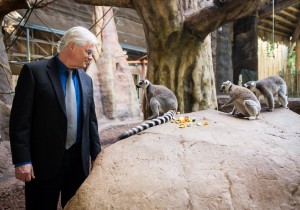RICHARD’S REVIEWS FOR APR. 4, 2014 W “CANADA AM” HOST BEVERLY THOMSON.
 Richard Crouse sounds off on his reviews for this week’s releases: ‘Captain America: The Winter Soldier’ and ‘Island of Lemurs: Madagascar.’
Richard Crouse sounds off on his reviews for this week’s releases: ‘Captain America: The Winter Soldier’ and ‘Island of Lemurs: Madagascar.’
Watch the whole thing HERE!
 Richard Crouse sounds off on his reviews for this week’s releases: ‘Captain America: The Winter Soldier’ and ‘Island of Lemurs: Madagascar.’
Richard Crouse sounds off on his reviews for this week’s releases: ‘Captain America: The Winter Soldier’ and ‘Island of Lemurs: Madagascar.’
Watch the whole thing HERE!
 By Richard Crouse – Metro Canada
By Richard Crouse – Metro Canada
David Douglas, the veteran wildlife filmmaker behind the new IMAX film Madagascar: Island of Lemurs, has dreamed of making a film on the island country in the Indian Ocean for thirty years.
He calls it a “remote and mythic place,” but adds, “in wildlife filmmaking everybody wants to go there and do it but you never can.”
But three things convinced him to take a chance and travel there “to figure out how to make the movie.”
First was the story of primatologist Dr. Patricia Wright. Douglas came across her while doing research for another film, but was taken with her efforts to protect Madagascar’s lemurs, whose numbers are shrinking to alarming levels. Around since the time of the dinosaurs, the big-eyed creatures arrived on the island as castaways from Africa and have now evolved into hundreds of species.
Douglas wanted to shine a light on Wright’s efforts to protect the lemur’s delicate ecosystem and raise awareness of their plight.
The second thing was a technological advancement.
“The normal situation in wildlife filmmaking is you have film stock, this resource that costs money and it runs through the camera in a certain amount of time,” he says. “It can’t be any longer. You have to reload it. So you have to spend a lot of your life trying to put yourself in the position of accurately predicting what an animal is going to do in the future because you want to have your camera running while its happening. That is the foundation of all of your planning and everything you do. That’s why you never see whales coming out of the water (in movies), you always see them falling back in.”
New IMAX equipment developed for this film allowed him to shoot digitally, on cameras with lots of memory. “The camera is always on and all we do is turn it off when we like what we got.”
The third draw was, of course, the lemurs themselves.
“They are spectacular looking. They look like a pile of toys in your kid’s closet because they’re all different, but they’re all sort of similar.”
The first things you notice about them are their prominent eyes. “Their eyes are radically different colors for the different species,” says Douglas. “They have every color of the rainbow of eyes.”
“Then there is the range of physical sizes. The mouse lemurs are the smallest primate on earth and up until humans got the last ones, there were really big lemurs on Madagascar; much bigger than a human being.
“Gosh, they’re fascinating animals,” he says with a hint of wonder in his voice.
 Would you spend money to see an animated movie starring Nicole Jaffe and Henry Corden? Probably not, because you’ve never heard of either of them.
Would you spend money to see an animated movie starring Nicole Jaffe and Henry Corden? Probably not, because you’ve never heard of either of them.
Oh, but you’ve heard them.
Jaffe voiced Velma on Scooby Doo, while Corden vocalized for Fred Flintstone. Their voices are familiar, but not well-known enough for the producers of big budget cartoons like Madagascar: Escape 2 Africa, opening in theatres this weekend.
“If they were doing a half-hour Flintstone show today, they’d still go with me,” said Corden in 1999, “but for a motion picture, even an animated one, they’d go with a celebrity to play Fred, because they need to sell the picture.”
Big-name actors who made their bones in live action have become the norm in modern animation.
Madagascar redux features everyone from Ben Stiller to Jada Pinkett Smith. Somewhere Nicole Jaffe is standing in a bank line waiting to cash her unemployment cheque.
In the old days, Disney frequently used celebrity voices to augment their cartoons — remember Sebastian Cabot in The Jungle Book? — but the trend kicked into overdrive when Robin Williams’s hyperkinetic jabbering stole the show in Aladdin.
It was a tour de force performance and Williams’s star power helped push the box office past $200,000,000, an animated film first.
Marquee actors like voice work for the same reason I like doing my radio show — the hours are good and you don’t have to shave.
Marlon Brando was so taken with the easy money of voice acting he suggested doing the role of Superman’s Jor-El in voice-over, with his onscreen character portrayed as a glowing, levitating green bagel. That one didn’t pan out but he took further audio-only roles, including his final gig performing an old lady voice in the unreleased Big Bug Man.
Other star turns haven’t been so ignoble. Jeremy Irons was positively Shakespearean as The Lion King’s Scar and Orson Welles thrilled a generation of tweens as the voice of planet-gobbler Unicron in Transformers: The Movie.
But too often the big names offer little other than recognizable voices, and that can work against the part they’re playing.
Can you hear James Earl Jones as Mufasa without thinking of Darth Vader? Me neither.
It boils down to bucks —David Schwimmer’s Melman the Giraffe will put more bums in seats than Henry Corden. It’s not about talent, it’s about money. “I hate it but I understand it,” Corden said.